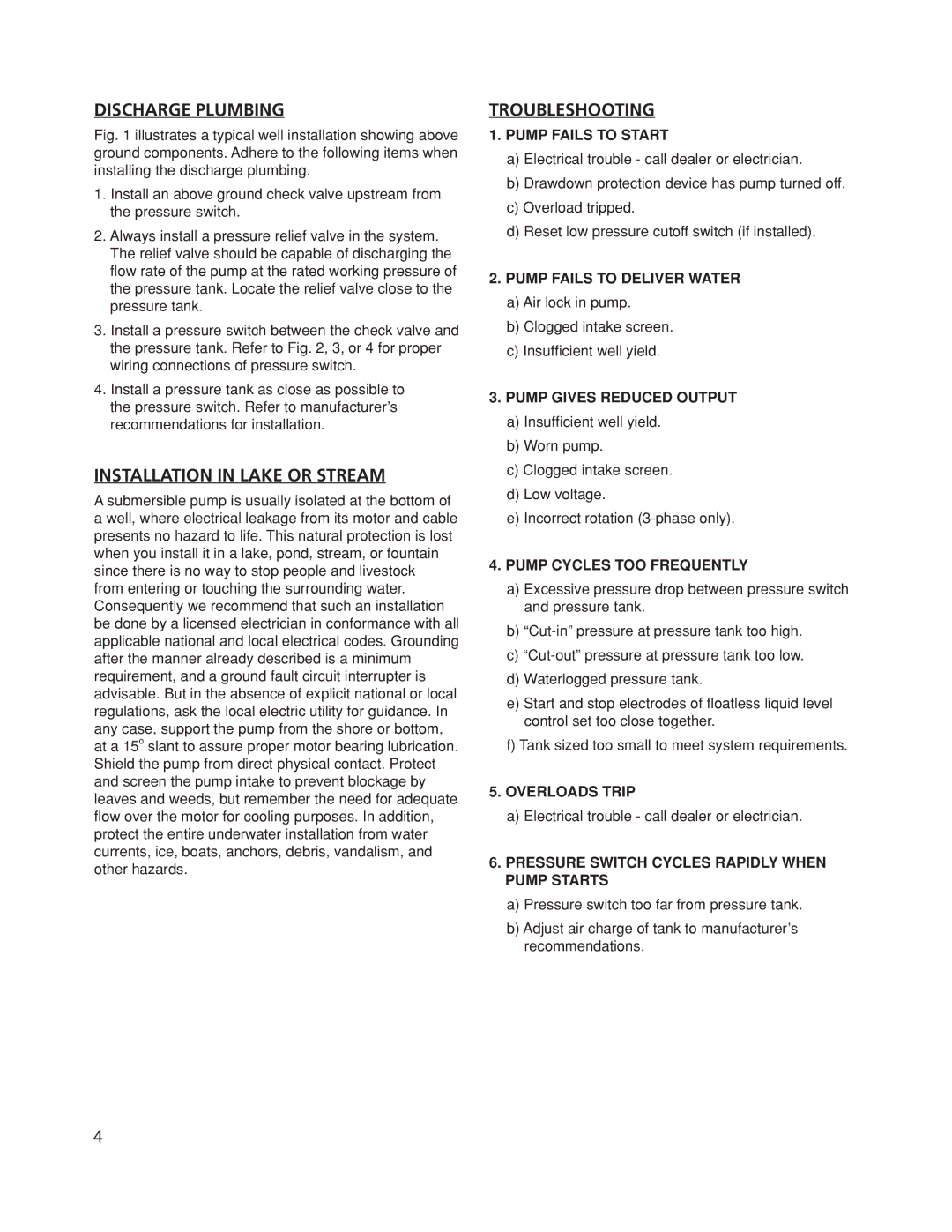DISCHARGE PLUMBING
Fig. 1 illustrates a typical well installation showing above ground components. Adhere to the following items when installing the discharge plumbing.
1.Install an above ground check valve upstream from the pressure switch.
2.Always install a pressure relief valve in the system. The relief valve should be capable of discharging the flow rate of the pump at the rated working pressure of the pressure tank. Locate the relief valve close to the pressure tank.
3.Install a pressure switch between the check valve and the pressure tank. Refer to Fig. 2, 3, or 4 for proper wiring connections of pressure switch.
4.Install a pressure tank as close as possible to the pressure switch. Refer to manufacturer’s recommendations for installation.
INSTALLATION IN LAKE OR STREAM
A submersible pump is usually isolated at the bottom of a well, where electrical leakage from its motor and cable presents no hazard to life. This natural protection is lost when you install it in a lake, pond, stream, or fountain since there is no way to stop people and livestock from entering or touching the surrounding water. Consequently we recommend that such an installation be done by a licensed electrician in conformance with all applicable national and local electrical codes. Grounding after the manner already described is a minimum requirement, and a ground fault circuit interrupter is advisable. But in the absence of explicit national or local regulations, ask the local electric utility for guidance. In any case, support the pump from the shore or bottom, at a 15o slant to assure proper motor bearing lubrication. Shield the pump from direct physical contact. Protect and screen the pump intake to prevent blockage by leaves and weeds, but remember the need for adequate flow over the motor for cooling purposes. In addition, protect the entire underwater installation from water currents, ice, boats, anchors, debris, vandalism, and other hazards.
TROUBLESHOOTING
1.PUMP FAILS TO START
a)Electrical trouble - call dealer or electrician.
b)Drawdown protection device has pump turned off.
c)Overload tripped.
d)Reset low pressure cutoff switch (if installed).
2.PUMP FAILS TO DELIVER WATER
a)Air lock in pump.
b)Clogged intake screen.
c)Insufficient well yield.
3.PUMP GIVES REDUCED OUTPUT
a)Insufficient well yield.
b)Worn pump.
c)Clogged intake screen.
d)Low voltage.
e)Incorrect rotation
4.PUMP CYCLES TOO FREQUENTLY
a)Excessive pressure drop between pressure switch and pressure tank.
b)
c)
d)Waterlogged pressure tank.
e)Start and stop electrodes of floatless liquid level control set too close together.
f)Tank sized too small to meet system requirements.
5.OVERLOADS TRIP
a)Electrical trouble - call dealer or electrician.
6.PRESSURE SWITCH CYCLES RAPIDLY WHEN PUMP STARTS
a)Pressure switch too far from pressure tank.
b)Adjust air charge of tank to manufacturer’s recommendations.
4
